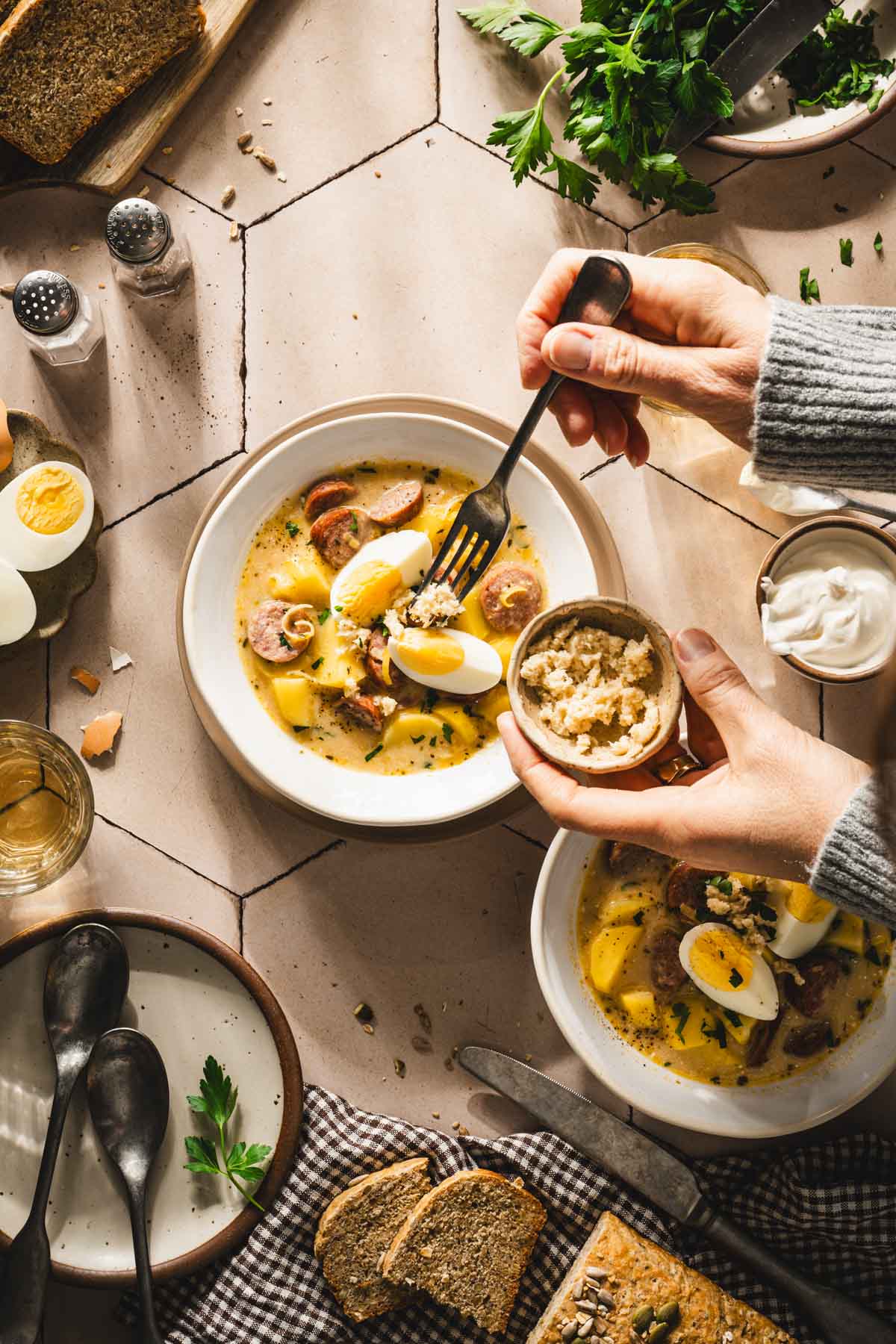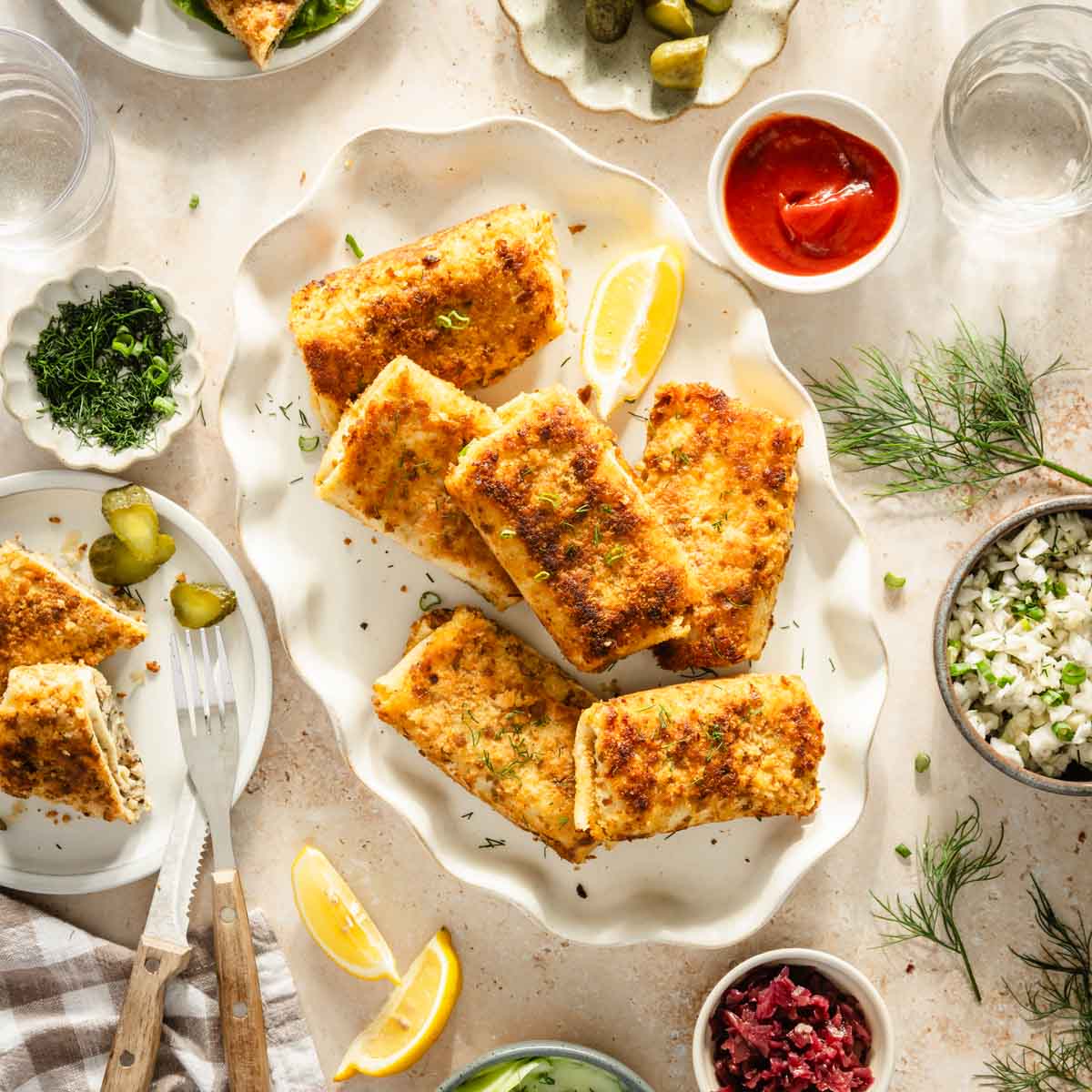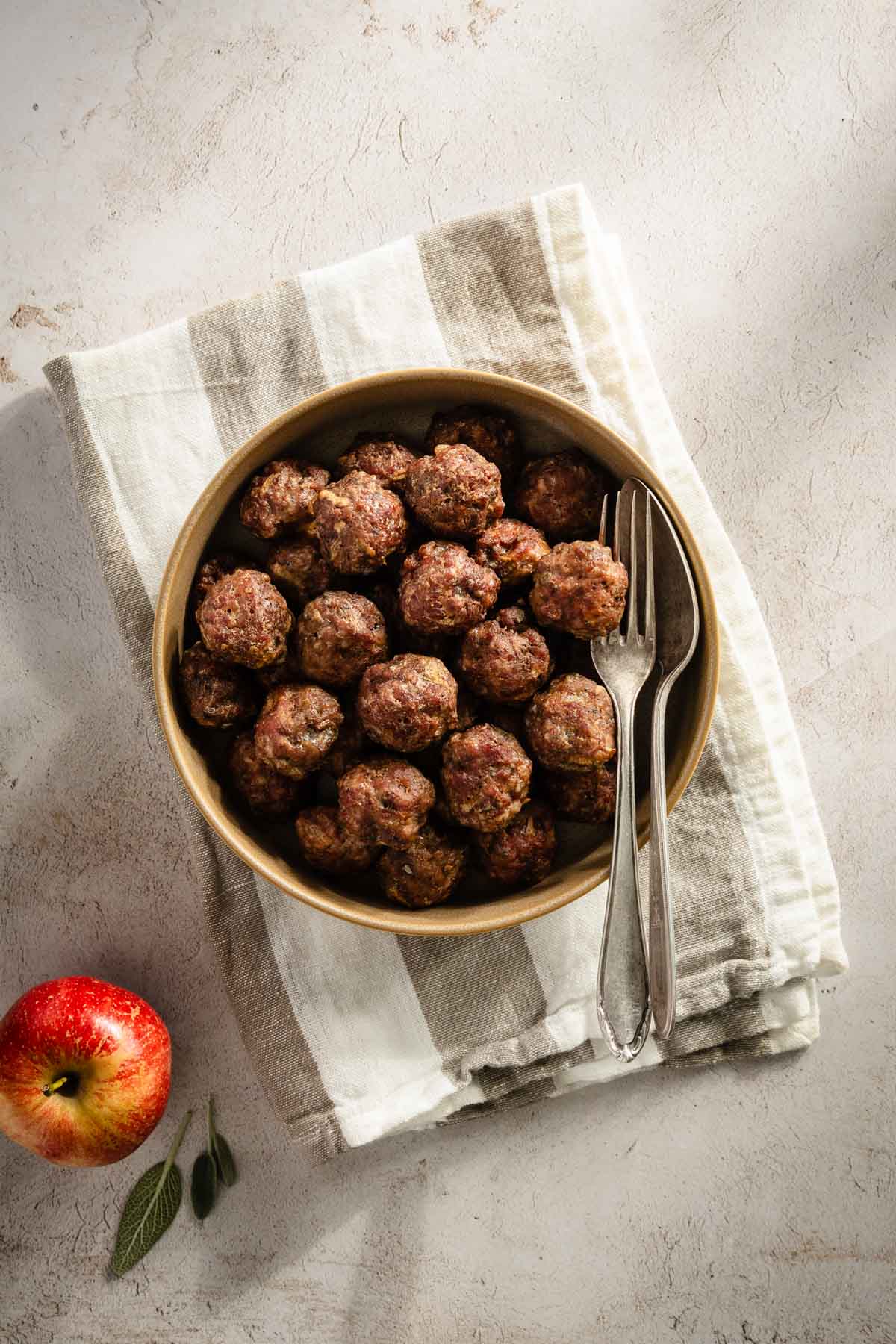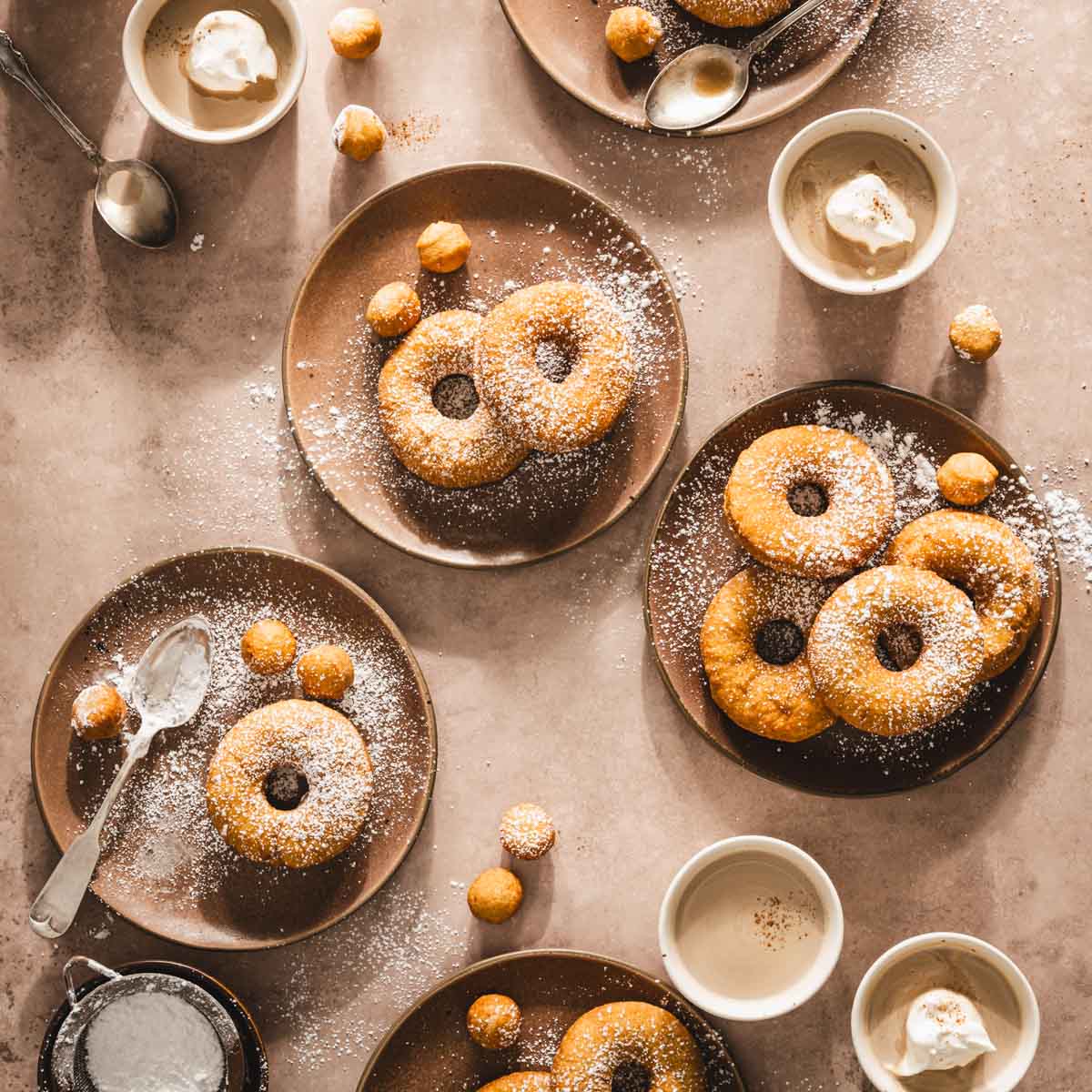How to make Polish White Borscht – Barszcz Bialy
Creamy, tangy, and packed with deep, savory flavors, Barszcz Biały (White Borscht Soup) is Polish classic comfort food at its best.
Polish White Borscht gets its signature tang from a sour wheat starter. The result? A slightly sour broth that pairs beautifully with smoky kielbasa, hearty potatoes, and hard-boiled egg.

This Polish White Borscht is an excellent recipe if you have ever considered sour soups. Enjoy it as a cozy weeknight meal or a festive traditional Polish soup on Easter Sunday morning.
Why you will love Polish White Borscht
Bright & tangy – the sauerkraut juice and zakwas create that signature flavor, not only Poles love.
Umami forward – the mushroom powder deepens the flavor, making the broth irresistible.
Creamy yet light – the potatoes and cream balance the soup, giving it a velvety texture without being too heavy.
Ingredients, Variations, and Substitutions

The sour taste of bialy barszcz comes from the wheat-based starter, a fermented base that takes 5–7 days to develop, so a little planning ahead is essential. If you prefer a tangier flavor, you can swap it for a rye-based żur, or a quick alternative, a splash of sauerkraut juice or pickled cucumber brine can bring similar sour complexity.
The broth flavor is created by using homemade bouillon cubes (you can also use chicken broth), that is simmered on low heat with smoked Polish sausage (or white kielbasa) or pork bones (like pork ribs or ham hock). For a lighter variation, a mix of vegetable broth and mushroom powder (made by grinding dried mushrooms) brings umami depth without the meat.
Fresh thyme, marjoram, bay leaves, allspice berries, and smoked paprika enhance the aroma of this soup.
Garlic and leek, lightly cooked in butter, provide a flavorful backbone, tying everything together.
For a little extra punch, a teaspoon of grated horseradish stirred in at the end or used as a garnish adds a sharp, peppery kick.
Heavy cream or sour cream are the classic choices to achieve the soup’s signature creamy texture. Cashew cream makes an excellent dairy-free alternative.
For the Zakwas (wheat flour starter)

The foundation of wheat-based zakwas is whole wheat flour, which provides the natural starches and wild yeast needed for fermentation. You can experiment with whole rye flour for a slightly different depth of flavor.
Water is the other essential ingredient – filtered or boiled and cooled water is best to prevent unwanted bacteria from interfering with the fermentation. To kickstart the process, a small amount of fermented liquid like sauerkraut juice or pickle brine can be added, though it’s entirely optional.
For seasoning, garlic cloves and bay leaves infuse the zakwas with a subtle, earthy aroma, while black peppercorns and allspice berries add a hint of warmth.
In this version, I used dark rye bread to add extra depth. This also helps to introduce natural yeasts and lactic acid bacteria to jump-start fermentation. It added more depth to your wheat-based zakwas, making it more aromatic and slightly tangy. Toasting the bread can give it a deeper, almost malty note.


Equipment you will need
- Large pot (Dutch oven or soup pot)
- Cutting board & sharp knife
- Garlic press (or fine grater)
- Measuring spoons & cups
- Wooden spoon, spatula
- Slotted spoon
- Small bowl
- Large glass jar
- Cheesecloth
- Fine-mesh strainer (for the zakwas)

Top Tips
Simmer, don’t boil – keep the soup at a gentle simmer to allow all the flavors to meld together without evaporating too much liquid. Boiling too vigorously can make the potatoes fall apart too quickly and might mute the delicate flavors.
Temper the cream – to prevent curdling, mix a spoonful of warm broth with the cream before adding it to the soup. This gradually raises the temperature and ensures a smooth, creamy finish.
Taste & adjust the tanginess – the sauerkraut juice or pickled brine adds a signature sour note, but start with a little and adjust to taste. Too much at once can overpower the soup.
Don’t skip the umami boost – the mushroom powder deepens the broth’s savory notes. A final sprinkle of mushroom powder just before serving can make the flavors pop even more.
Step-by-step instructions
- Start by preparing the Zakwas – plan 5-7 days ahead.
- Mix the flour and lukewarm water in a clean glass jar until smooth. Use a wooden or plastic spoon (not metal).



- Add the garlic, bay leaf, and allspice berries. If you have some rye bread slices, tear them into smaller chunks and toss them in to help kickstart fermentation.
- Cover loosely with a clean cloth or coffee filter and let it sit at room temperature for 3-5 days, stirring once daily.
- Once it smells pleasantly sour (like fermented bread dough) and has a slightly bubbly texture, it’s ready! Strain before using if you prefer a smooth liquid.


- Heat a skillet or large pot over medium heat.
- Add butter, then sauté the chopped leek until softened.
- Stir in the garlic and cook for another 30 seconds until fragrant.



- Prepare the broth by dissolving the bouillon cubes in 4-6 cups of hot water.
- Pour the broth and add the bay leaf, allspice berries, and aromatics.
- Bring to a simmer.
- Add cubed potatoes and whole kielbasa to the pot.



- Let everything simmer for about 15-20 minutes, or until the potatoes are tender.
- Pour in the fermented flour starter (zakwas) and stir well.
- Add sauerkraut juice; start with a small amount and adjust to taste.
- Season with salt and black pepper, tasting as you go.
- Transfer a ladle or two of the soup into a small bowl. Add the cream to temper it.



- Slowly pour the tempered cream into the soup, stirring constantly to avoid curdling.
- Remove bay leaf and allspice berries.
- Taste and adjust seasoning. Add more brine if you want it tangier, more smoked paprika for depth, or more thyme for earthiness.
- Serve hot, garnished with sliced hard-boiled eggs, fresh dill, and rye bread on the side.

Best ways to enjoy Polish White Borscht
With rye bread and hard-boiled egg – the most traditional, classic way.
Topped with fresh dill or parsley – they add a fresh, aromatic contrast to the creamy soup.
With extra protein – add shredded smoked pork for a more filling dish.
Over mashed potatoes – super comforting and filling.
With a side of pierogi – pair with potato & cheese pierogi for the ultimate Polish comfort meal.
Turn it into a stew – toss in extra potatoes, white beans, or even sautéed mushrooms to make it chunkier.

You may also like:
Storage instructions, reheating
Refrigeration: Once cooled, transfer the soup to an airtight container and store it in the fridge for up to 4-5 days.
Freezing: This soup freezes well without the eggs and cream. If you plan to freeze it, store the broth separately and add fresh eggs and cream when reheating. It can be kept in the freezer for up to 3 months.
Reheating
Stovetop: pour the soup into a pot and reheat over medium heat, stirring occasionally. If the soup has thickened in the fridge, add a splash of broth or water to adjust the consistency.
Microwave: heat in a microwave-safe bowl in 30-second intervals, stirring in between, until warmed through.
After freezing: If reheating from frozen, thaw in the fridge overnight before warming on the stovetop.



How to make Polish White Borscht – Barszcz Bialy
Equipment
- Dutch oven, soup pot
- cutting board & sharp knife
- measuring cups and spoons
- garlic press
- wooden spoon
- Glass jar
- cheesecloth
- strainer
Ingredients
For the Soup
- 6 cups broth chicken or pork-based, or water for a lighter version
- 1 cup zakwas fermented wheat starter – or make a quick version with sourdough bread soak
- 8 oz smoked kielbasa
- 2 tbsp butter
- 2 cloves garlic minced
- 1 medium leek white and light green parts, chopped
- 3-4 small potatoes peeled and cubed
- 1 bay leaf
- 3-4 allspice berries
- ½ tsp marjoram dried
- ½ tsp Smoked paprika
- ½ tsp thyme
- 1 tsp Mushroom powder
- 1 tbsp horseradish grated
- ½ cup heavy cream or sour cream for creaminess
- 2 tbsp sauerkraut juice or pickled cucumber brine
- Salt and pepper to taste
For the Zakwas
- ½ cup wheat flour preferably whole wheat, but all-purpose works too
- 2 cups lukewarm water
- 2 garlic cloves smashed
- 1 bay leaf
- 3-4 allspice berries
- 1-2 tbsp dark rye bread crumbs
Instructions
- In a clean glass jar, mix the flour and lukewarm water until smooth.
- Add the garlic, bay leaf, and allspice berries. If you have some sourdough breadcrumbs, toss them in to help kickstart fermentation.
- Cover loosely with a clean cloth or coffee filter and let it sit at room temperature for 3-5 days, stirring once daily.
- Once it smells pleasantly sour (like fermented bread dough) and has a slightly bubbly texture, it’s ready! Strain before using if you prefer a smooth liquid.
- Heat a skillet or Dutch oven over medium heat.
- Add butter and sauté the chopped leek until softened.
- Stir in the garlic and cook for another 30 seconds until fragrant.
- Prepare the broth by dissolving the bouillon cubes in 4-6 cups of hot water.
- Pour in the broth and add bay leaf, allspice berries, and aromatics. Bring to a simmer.
- Add cubed potatoes and whole kielbasa to the pot.
- Let everything simmer for about 15 minutes, or until the potatoes are tender.
- Pour in the zakwas (fermented rye starter) and stir well.
- Add sauerkraut juice for extra tanginess.
- Season with salt and pepper, tasting as you go.
- Mix the cream with a ladle of broth in a small bowl to temper it.
- Slowly pour the tempered cream into the soup, stirring constantly to avoid curdling.
- Remove bay leaf and allspice berries.
- Taste and adjust seasoning. Serve topped with hard-boiled egg and fresh herbs.
Notes
Nutrition
Did you make this recipe?
Tag me @sylwiavaclavekphotography or tag me using #myomnikitchen so I can see your creations! You can also leave a comment below!
Conclusion
Barszcz Biały, known as Polish Easter Soup, is more than just a soup for a special occasion. It’s a comforting, tangy, and savory dish that brings tradition to your table.
With its deep flavors from fermented rye, smoked paprika, and mushroom powder’s umami, this delicious soup delivers flavors and textures. Whether you enjoy it with a slice of crusty bread, a hard-boiled egg, or a hearty kielbasa, each spoonful is a taste of Polish culinary heritage.


FAQ
What is the difference between Barszcz Biały and Żurek?
While both soups are tangy and made with fermented rye starter (zakwas), Barszcz Biały uses wheat-based zakwas, making it milder and slightly creamier, while Żurek has a deeper, more sour flavor from rye fermentation. Barszcz Biały is often paired with a smoother broth, whereas Żurek is heartier with a more pronounced tang.
What is Zakwas?
Zakwas is a fermented sourdough starter made from flour, water, and aromatics like garlic and bay leaf. Over a few days, natural fermentation creates lactic acid, which gives the soup its characteristic sour taste.
Can I make Barszcz Biały without zakwas?
Yes! While zakwas gives it the signature tang, you can substitute with a mix of sauerkraut juice, pickled cucumber brine, or a splash of apple cider vinegar. It won’t have the same depth of flavor, but it will still be delicious.
What’s the best sausage to use in this soup?
Traditional Polish biała kiełbasa (white sausage) is the classic choice. If unavailable, try using smoked kielbasa, bratwurst, or even a mild pork sausage to keep the rich, savory flavor.
When should I add the horseradish?
Horseradish should be added at the end of cooking or just before serving. This keeps its punchy, spicy flavor intact, rather than losing it’s heat during cooking. Start with a teaspoon and adjust to taste.
Can I make this soup vegetarian?
Absolutely! Skip the sausage and use a rich vegetable broth. Boost umami by adding mushroom powder (ground wild dried mushrooms), smoked paprika, and an extra splash of sauerkraut juice or brine to replace the depth that meat provides.
How can I thicken the soup?
For a thicker consistency, you can:
– Mash some of the potatoes directly in the soup.
– Stir in a small amount of flour mixed with cold water (slurry) and let it simmer for a few minutes.







